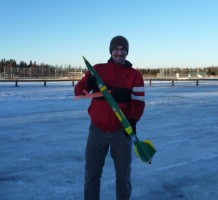UAA students compete in NASA rocketry competition
by Michelle Saport |

Team member John Berg, a mechanical engineering major, holds the sub-scale rocket launched in early January.
For the first time in UAA history, a team of UAA undergraduate and graduate students will compete in the annual National Aeronautics and Space Administration (NASA) Student Launch Initiative. The Student Launch Initiative allows teams of interdisciplinary college students to design, develop and launch a reusable rocket known as a Mars Ascent Vehicle, or MAV. The design includes an autonomous robot arm that must lift a small payload into the rocket prior to launch to an altitude of 3,000 feet. The intent of the NASA initiative is to encourage research-based, competitive and experiential exploration projects that provide relevant and cost- effective research and development, along with NASA's goal to connect communities with science, technology, engineering and mathematics (STEM) opportunities.
In addition to the students, the team has a NASA-directed team mentor to provide safety guidance and advise the team on rocket design. The UAA team's mentor, David Erickson, who founded the Anchorage chapter of the National Association of Rocketry (NAR), also oversees local launch activities for the team and will travel with the team to the competition launch site. About his role, Erickson stated, "it boils down to having an experienced rocketeer involved in the process, focused on safety, and passing down my expertise to the team."
During the recent winter break, the UAA team was busy building and launching a sub-scale rocket as part of their next step in their design review process. On Jan. 3 and again on Jan. 9, the team successfully launched their sub-scale model.
During the recent rocket launch, Erickson stated, "NASA's intent is to get the team's mindset on the process involved with constructing and flying a rocket. And it allows the team to gather and analyze data prior to building their full scale rocket."
In addition, team leader and mechanical engineering major Brandon Grimshaw acknowledged that "we are collecting data from this rocket required for the next competitive phase in this project-how to get our parachutes and charges to deploy and our altimeters to work properly on our main rocket for the Huntsville, Ala. launch. We have put in countless hours thus far. Building this sub-scale rocket alone took about 100 hours from four team members."
The UAA team's NASA Student Launch Initiative process actually started back in September 2014 when the NASA request for proposals went out to colleges and universities. After submitting a proposal in early October, the team was notified of their acceptance at the end of October, in time for the team to draft a Preliminary Design Review (PDR) report and presentation by early November. The PDR was a competitive first-step in the design review process, mirroring the NASA engineering design lifecycle and providing the team with a unique experience that will prepare them for work in engineering, exploration and operations career fields.
Following a thorough scrutiny of the team's PDR and a video teleconference where student mechanical and electrical engineering team members presented NASA scientists and engineers with design details, NASA accepted the UAA team for the next step, the Critical Design Review. After submission of the CDR and an additional video teleconference with NASA specialists in late-January, the team will hopefully move on through two more competitive review steps: the Flight Readiness Review in March 2015; and Launch Readiness Review that will occur in Huntsville, Ala. in April 2015 as part of the final competitive phase. NASA will announce the winning team in May 2015. All competing college and university teams are eligible for awards through the Student Launch Initiative.
In addition to the design and successful operation of the rocket system, the UAA team is also required to meet community outreach milestones directed by NASA as part of its STEM outreach mission. The minimum team outreach goal is to provide hands-on STEM educational experiences to 200 participants, including at least 100 middle school students. As of now, the team intends to engage with Girl Scout and Boy Scout troops, local middle and high schools, and offer activities during UAA Engineers Week in February 2015.
NASA Student Launch Initiative competitors are not supported by government funding. All funding for parts, equipment, outreach activities and team travel are based on donations and educational grants. If interested in additional information, STEM outreach opportunities or donations, please visit the UAA Rocketry Club website at uaarocketry.com or the team's Facebook page at facebook.com/uaarocketry. (The UAA Rocketry team will also be the focus of a feature story in the Jan. 28 Seawolf Weekly — stay tuned.)
 "UAA students compete in NASA rocketry competition " is licensed under a Creative Commons Attribution-NonCommercial 4.0 International License.
"UAA students compete in NASA rocketry competition " is licensed under a Creative Commons Attribution-NonCommercial 4.0 International License.









